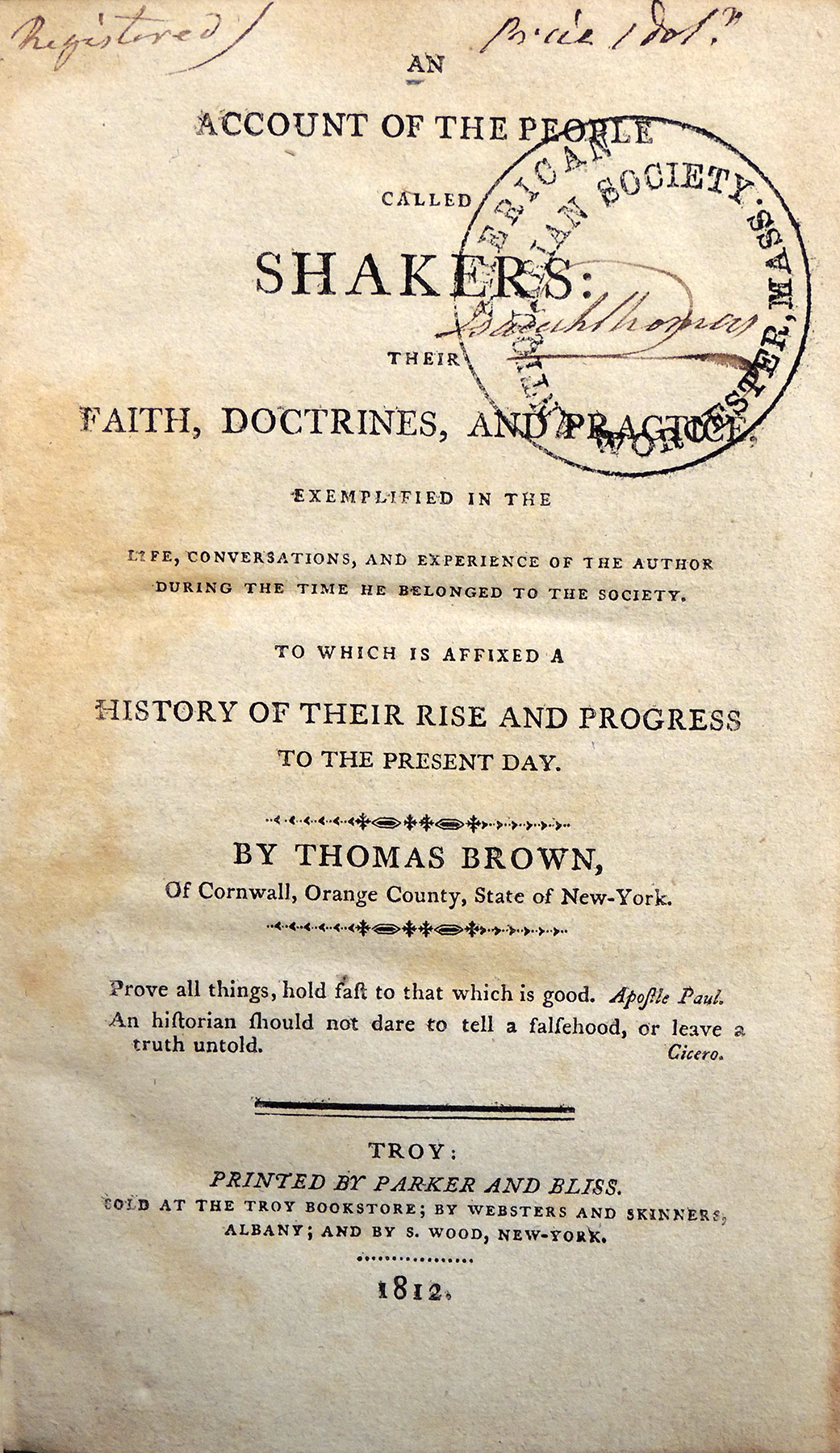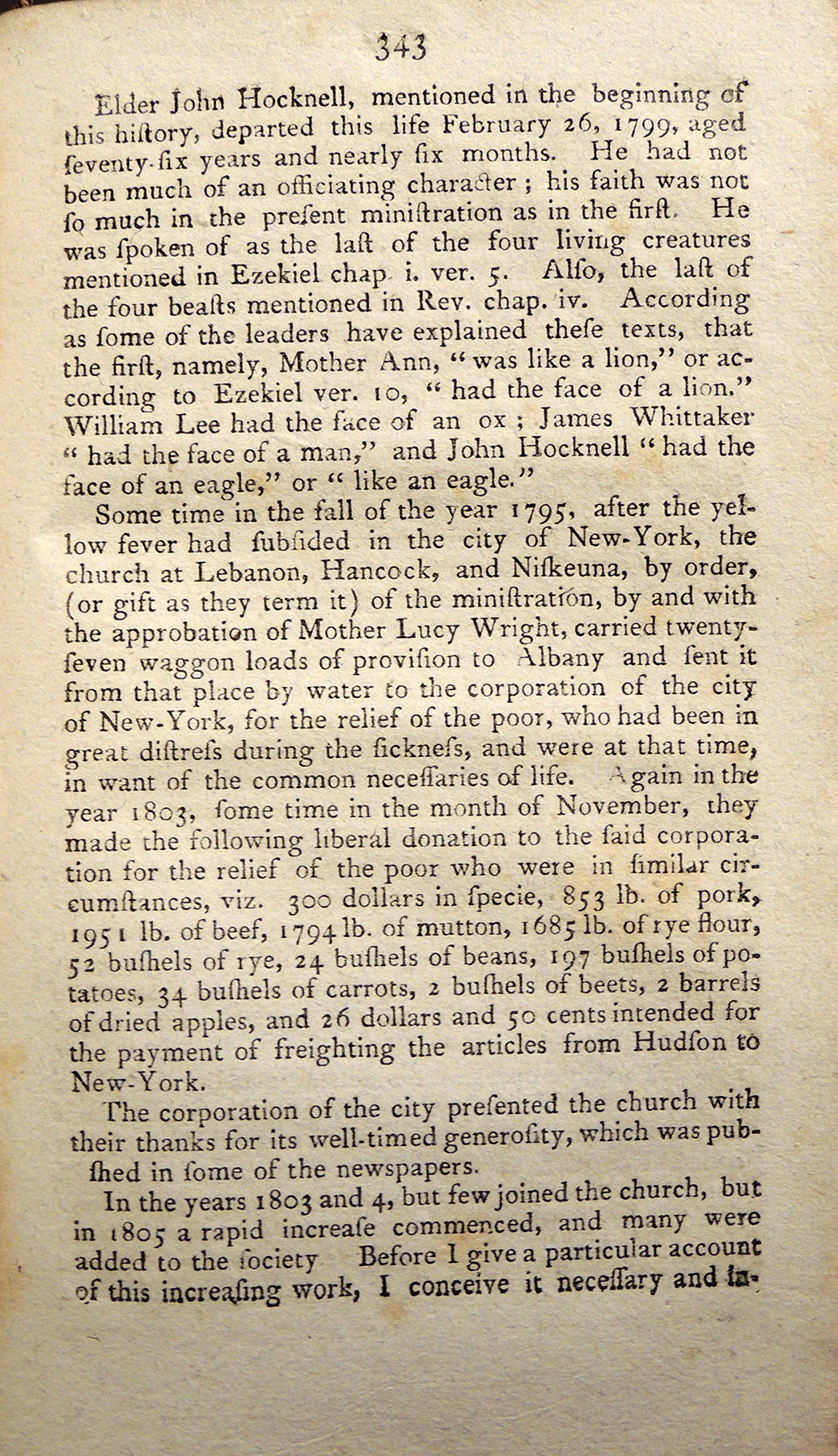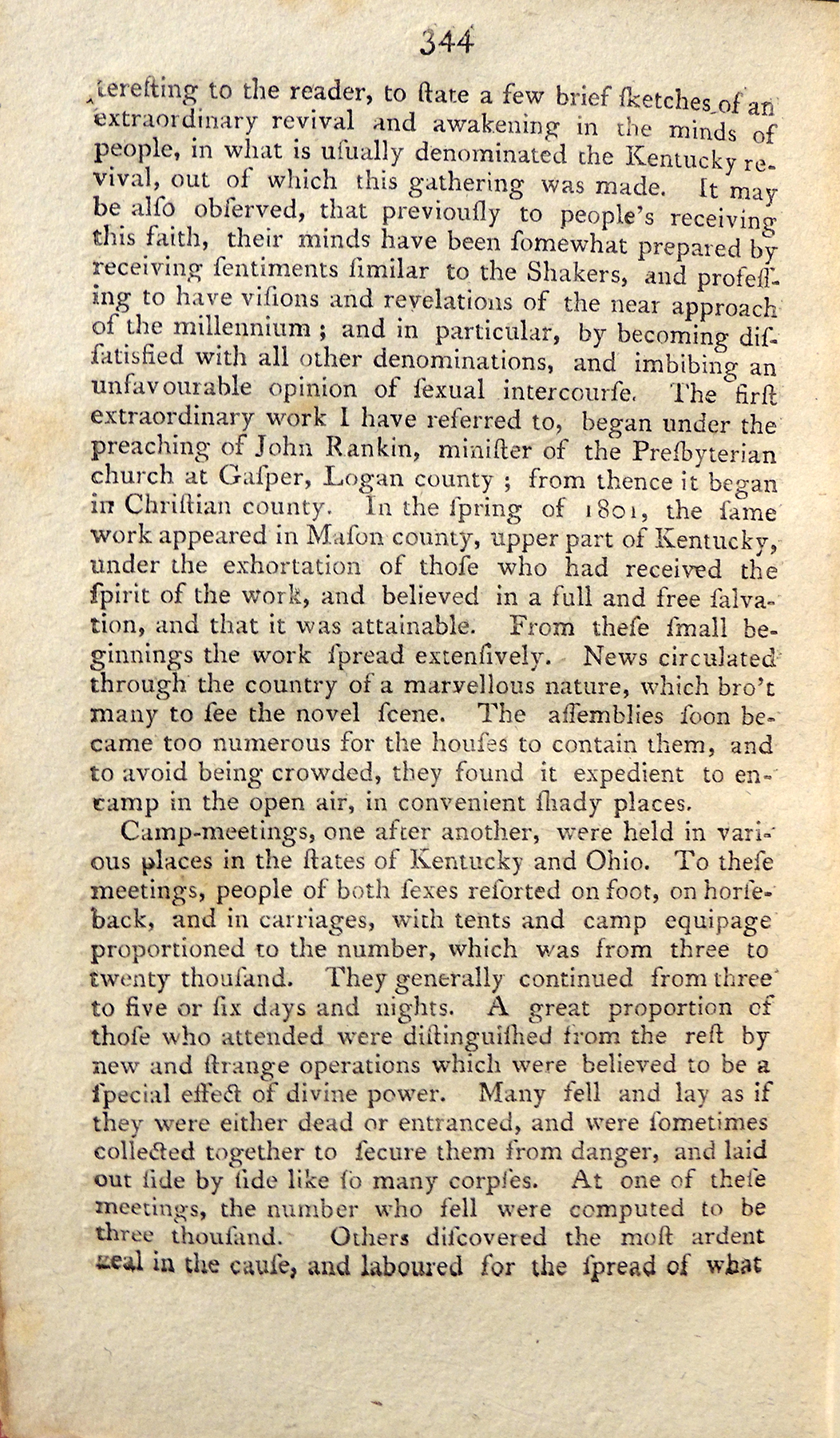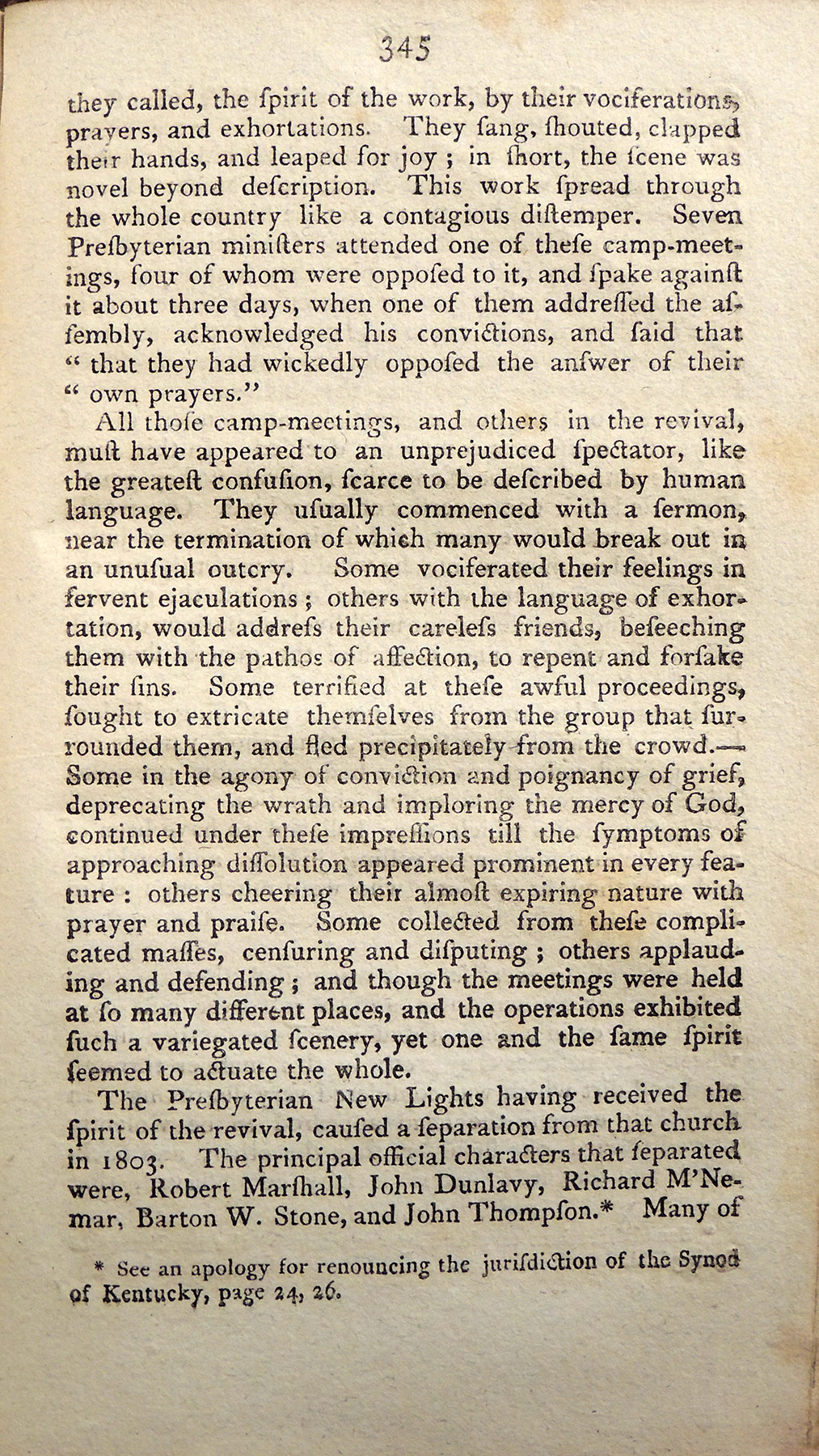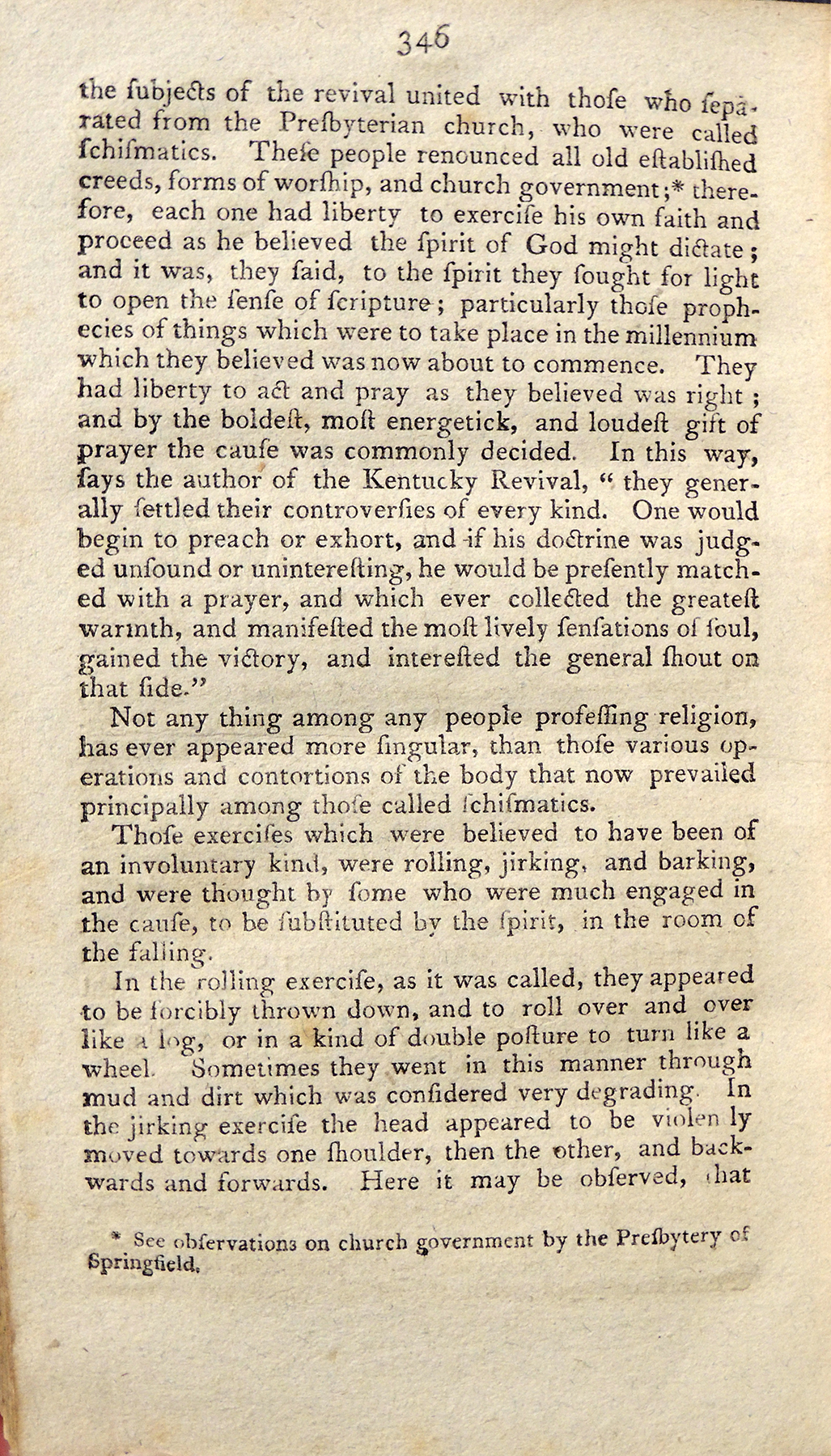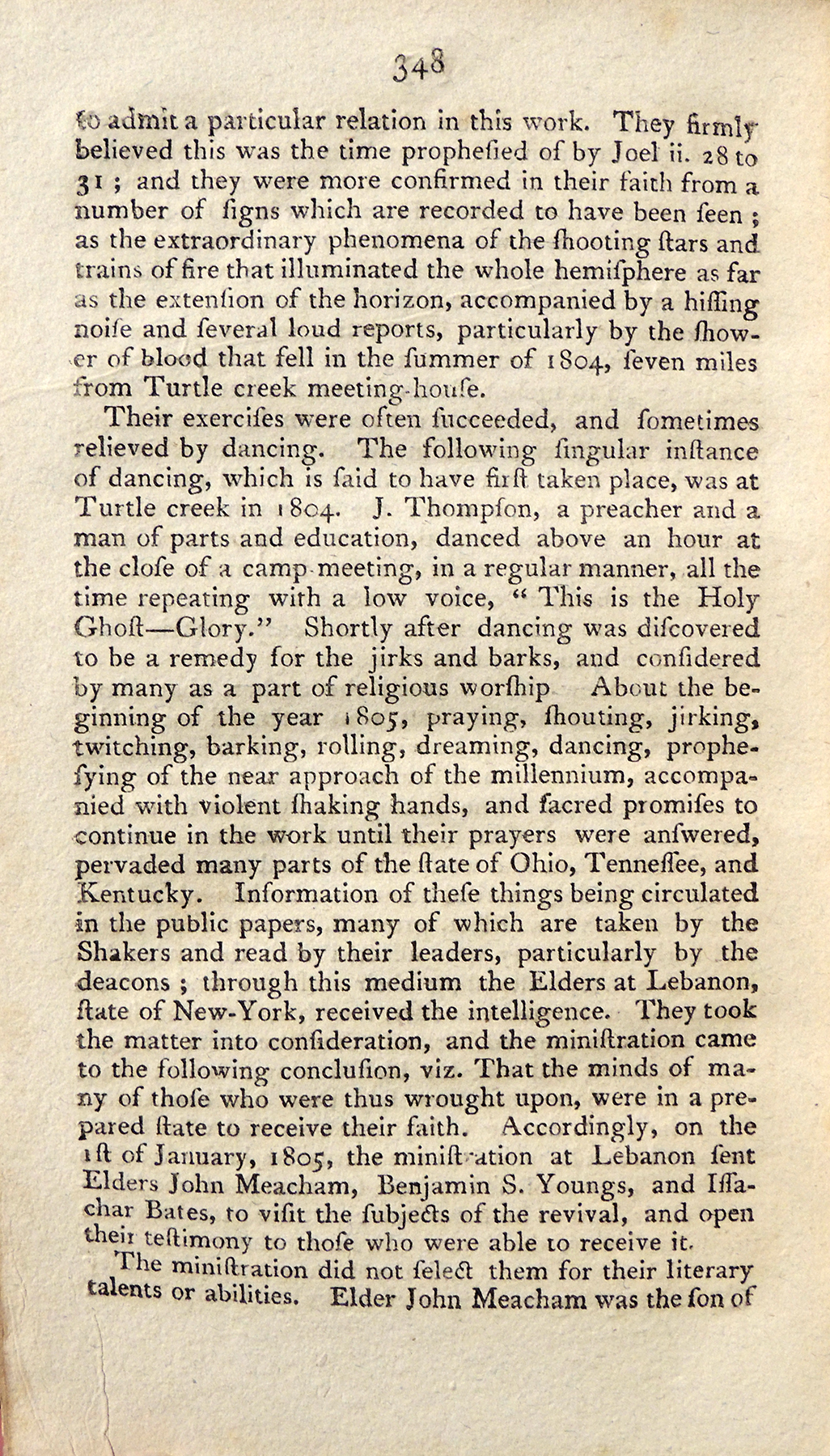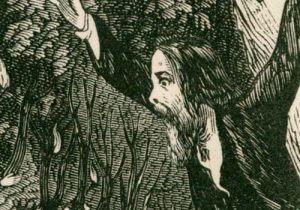Thomas Brown’s well-known anti-Shaker tract contains a concise summary of the western revivals, the New Light schism, and bodily exercises, including the jerks. Brown relied primarily on published sources, especially Richard McNemar’s Kentucky Revival, but he also introduced specific details about the jerks based on his conversations with Methodist itinerant Lorenzo Dow. Contextual notes appear in square brackets. Click here for the full text of Brown’s Account of the People Called Shakers (1812).
In the years 1803 and 4, but few joined the church [i.e., the Shakers], but in 1805 a rapid increase commenced, and many were added to the society. Before I give a particular account of this increasing work, I conceived it necessary and interesting to the reader, to state a few brief sketches of an extraordinary revival and awakening in the minds of people, in what is usually denominated the Kentucky revival, out of which this gathering was made. It may be also observed, that previously to people’s receiving this faith, their minds have been somewhat prepared by receiving sentiments similar to the Shakers, and professing to have visions and revelations of the near approach of the millennium; and in particular, by becoming dissatisfied with all other denominations, and imbibing an unfavourable opinion of sexual intercourse. The first extraordinary work I have referred to, began under the preaching of John Rankin, minister of the Presbyterian church at Gasper, Logan county; from thence it began in Christian county. In the spring of 1801, the same work appeared in Mason county, upper part of Kentucky, under the exhortation of those who had received the spirit of the work, and believed in a full and free salvation, and that it was attainable. From these small beginnings the work spread extensively. News circulated through the country of a marvellous nature, which bro’t many to see the novel scene. The assemblies soon became too numerous for the houses to contain them, and to avoid being crowded, they found it expedient to encamp in the open air, in convenient shady places.
Camp-meetings, one after another, were held in various places in the states of Kentucky and Ohio. To those meetings, people of both sexes resorted on foot, on horseback, and in carriages, with tents and camp equipage proportioned to the number, which was from three to twenty thousand. They generally continued from three to five or six days and nights. A great proportion of those who attended were distinguished from the rest by new and strange operations which were believed to be a special effect of divine power. Many fell and lay as if they were either dead or entranced, and were sometimes collected together to secure them from danger, and laid out side by side like so many corpses. At one of these meetings, the number who fell were computed to be three thousand. Others discovered the most ardent zeal in the cause, and laboured for the spread of what they called, the spirit of the work, by their vociferations, prayers, and exhortations. They sang, shouted, clapped their hands, and leaped for joy; in short, the scene was novel beyond description. This work spread through the whole country like a contagious distemper. Seven Presbyterian ministers attended one of the camp-meetings, four of whom were opposed to it, and spake against it about three days, when one of them addressed the assembly, acknowledging his convictions, and said that “they had wickedly opposed the answer of their own prayers.”
All those camp-meetings, and others in the revival, must have appeared to an unprejudiced spectator, like the greatest confusion, scarce to be described by human language. They usually commenced with a sermon, near the termination of which many would break out in an unusual outcry. Some vociferated their feelings in fervent ejaculations; others with the language of exhortation, would address their careless friends, beseeching them with the pathos of affection, to repent and forsake their sins. Some terrified at these awful proceedings, fought to extricate themselves from the group that surrounded them, and fled precipitately from the crowd.—Some in the agony of conviction and poignancy of grief, deprecating the wrath and imploring the mercy of God, continued under these impressions till the symptoms of approaching dissolution appeared prominent in every feature: others cheering their almost expiring nature with prayer and praise. Some collected from these complicated masses, censuring and disputing; others applauding and defending; and though the meetings were held at so many different places, and the operations exhibited such a variegated scenery, yet one and the same spirit seemed to actuate the whole.
The Presbyterian New Lights having received the spirit of the revival, caused a separation from that church in 1803. The principal official characters that separated were, Robert Marshall, John Dunlavy, Richard M’Nemar, Barton W. Stone, and John Thompson.[*] Many of the subjects of the revival united with those who separated from the Presbyterian church, who were called schismatics. These people renounced all old established creeds, forms of worship, and church government;[*] therefore, each one had liberty to exercise his own faith and proceed as he believed the spirit of God might dictate; and it was, they said, to the spirit they fought for light to open the sense of scripture; particularly those prophecies of things which were to take place in the millennium which they believed was now about to commence. They had liberty to act and pray as they believed was right; and by the boldest, most energetick, and loudest gift of prayer the cause was commonly decided. In this way, says the author of the Kentucky Revival, “they generally settled their controversies of every kind. One would begin to preach or exhort, and if his doctrine was judged unsound or uninteresting, he would be presently matched with a prayer, and which ever collected the greatest warmth, and manifested the most lively sensations of soul, gained the victory, and interested the general shout on that side.”
Not any thing among any people professing religion, has appeared more singular, than those various operations and contortions of the body that now prevailed principally among those called schismatics.
Those exercises which were believed to have been of an involuntary kind, were rolling, jirking, and barking, and were thought by some who were much engaged in the cause, to be substituted by the spirit, in the room of the falling.
In the rolling exercise, as it was called, they appeared to be forcibly thrown down, and to roll over and over like a log, or in a kind of double posture to turn like a wheel. Sometimes they went in this manner through mud and dirt which was considered very degrading. In the jirking exercise the head appeared to be violently moved toward one shoulder, then the other, and backwards and forwards. Here it may be observed, that during the time they were under these operations, though they were often exposed to imminent danger, yet few received any hurt. It also seemed to be out of the power of the person thus affected to prevent it. One instance among many others was related to the author by Lorenzo Dow, a well known itinerant preacher; while he was preaching in Kentucky, one of his hearers appeared to be jirked about the house in a violent manner; after repeated attempted, he at last got out of the meeting-house; he attempted to mount his horse, but his feet were jirked every way so that he could not get them into the stirrups, when all his efforts proved ineffectual, two men set him on his horse, but he was immediately jirked off on the ground, where he lie under the operations of violent twiches and jirks for some time, yet he escaped without any hurt. People of every age, sex, sect, and condition appeared to be more or less affected with the disagreeable operations of these exercises, not only at their meetings, but in their daily employments.
Lorenzo Dow also informed the author, that about twenty Quakers in those parts who attended one of his meetings, were, just as he was beginning to preach, all taken with twitching and jirking, which to them was a great humiliation. The jirking exercise was sometimes accompanied, and often succeeded the barking. In this exercise both men and women personated and took the position of a dog, moved about in a horizontal posture upon their hands and feet, growled, snapped their teeth, and barked as if they were affected with the hydrophobia. But notwithstanding their suffering under these spasmodic or affected exercises, they had frequent intervals, in which they vociferated, that the work of God was increasing and that his blessed Kingdom was about to appear. Sometimes they said they had been absent from the body, during which time they had visited their departed friends, and seen their situation in the invisible world. They professed to hear the musick of the heavenly choir, and to be flung into rapturous extacies by the melodiousness of the sound. In short, the visions they professed to have had, and the strange operations they saw of things upon earth, would take up too much room to admit a particular relation to this work. They firmly believed this was the time prophesied of by Joel ii. 28 to 31; and they were more confirmed in their faith from a number of signs which are recorded to have been seen; as the extraordinary phenomena of the shooting stars and trains of fire that illuminated the whole hemisphere as far as the extension of the horizon, accompanied by a hissing noise and several loud reports, particularly by the shower of blood that fell in the summer of 1804, seven miles from Turtle creek meeting house.
Their exercises were often succeeded, and sometimes relieved by dancing. The following singular instance of dancing, which is said to have first taken place, was at Turtle creek in 1804. J. Thompson, a preacher and a man of parts and education, danced above an hour at the close of a camp meeting, in a regular manner, all the time repeated with a low voice, “This is the Holy Ghost—Glory.” Shortly after dancing was discovered to be a remedy for the jirks and barks, and considered by many as a part of religious worship. About the beginning of the year 1805, praying, shouting, jirking, twitching, barking, rolling, dreaming, dancing, prophesying of the near approach of the millennium, accompanied with violent shaking hands, and sacred promises to continue in the work until their prayers were answered, pervaded many parts of the state of Ohio, Tennessee, and Kentucky. Information of these things being circulated in the public papers, many of which were taken by the Shakers and read by their leaders, particularly by the deacons; through this medium the Elders at Lebanon, state of New-York, received the intelligence. They took the matter into consideration, and the ministration came to the following conclusion, viz. That the minds of many of those who were thus wrought upon, were in a prepared state to receive their faith. Accordingly, on the 1st of January, 1805, the ministration at Lebanon sent Elders John Meacham, Benjamin S. Youngs, and Issachar Bates, to visit the subjects of the revival, and open the testimony to those who were able to receive it.
[*] See observations on church government by the Presbytery of Springfield.
Source
Thomas Brown, An Account of the People Called Shakers: Their Faith, Doctrines, and Practice (Troy, N.Y.: Parker and Bliss, 1812), 343–348.
Images courtesy of the American Antiquarian Society, Worcester, Massachusetts.
